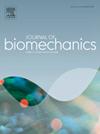使用肌肉骨骼模型来估计在动态举重任务中外骨骼对脊柱负荷的影响:OpenSim和任何人建模系统之间的差异
IF 2.4
3区 医学
Q3 BIOPHYSICS
引用次数: 0
摘要
职业背支撑外骨骼(bse)可以通过提供辅助扭矩来减少举重过程中的身体需求,但它们对脊柱负荷的影响尚不清楚。在这项研究中,我们使用在OpenSim和anyone建模系统中开发的两种常见肌肉骨骼模型来估计不对称和对称举重任务中有无BSEs的椎间关节力(IJF)。研究人员使用了一项早期研究的数据,涉及18名参与者,他们在三种不同的任务条件下和三种不同的BSE(以及没有BSE的控制条件)中重复进行降低/提升。我们模拟了这两种模型,并估计了L4/L5关节的轴向压缩力和前后剪力,并得出了峰值(第95百分位数)作为结果测量。OpenSim估计的轴向压缩和前后剪切力明显大于AMS。当使用任何一种BSEs时,两个模型都估计脊柱负荷的减少,尽管OpenSim估计的减少比AMS更大。强正线性关系(r >;对于轴压,两个模型之间的关系为0.95),而对于剪切力,特别是在不对称条件下,观察到的关系要弱得多,甚至是负的。模型估计的差异可能是由于模型假设和被动组织表征的变化。未来的研究应该探索更详细的人-外骨骼相互作用模型,评估建模假设对IJF估计的影响,并评估这些发现与体内测量(如肌电图)的一致性。本文章由计算机程序翻译,如有差异,请以英文原文为准。
Using musculoskeletal models to estimate the effects of exoskeletons on spine loads during dynamic lifting tasks: differences between OpenSim and the AnyBody modelling system
Occupational back-support exoskeletons (BSEs) can reduce physical demands during lifting by providing assistive torques, but their effects on spine loading are poorly understood. In this study, we used two common musculoskeletal models developed in OpenSim and the AnyBody Modeling System to estimate intervertebral joint forces (IJF) during asymmetric and symmetric lifting tasks with and without BSEs. Data from an earlier study were used, involving 18 participants who performed repetitive lowering/lifting in three task conditions and with three different BSEs (along with a control condition using no BSE). We simulated the tasks with both models and estimated axial compression and anteroposterior shear forces at the L4/L5 joint and derived peak values (95th percentile) as outcome measures. OpenSim estimated significantly larger axial compression and anteroposterior shear forces than AMS. Both models estimated reductions in spine loading when using either of the BSEs, though OpenSim estimated greater reductions than AMS. Strong positive, linear relationships (r > 0.95) between the two model estimates were found for axial compression, while much weaker and even negative relationships were observed for shear forces, especially under asymmetric conditions. The differences in model estimates were likely due to variations in model assumptions and passive tissue representations. Future research should explore more detailed human-exoskeleton interaction models, evaluate the impact of modelling assumptions on IJF estimates, and assess the agreement of these findings with in vivo measurements such as electromyography.
求助全文
通过发布文献求助,成功后即可免费获取论文全文。
去求助
来源期刊

Journal of biomechanics
生物-工程:生物医学
CiteScore
5.10
自引率
4.20%
发文量
345
审稿时长
1 months
期刊介绍:
The Journal of Biomechanics publishes reports of original and substantial findings using the principles of mechanics to explore biological problems. Analytical, as well as experimental papers may be submitted, and the journal accepts original articles, surveys and perspective articles (usually by Editorial invitation only), book reviews and letters to the Editor. The criteria for acceptance of manuscripts include excellence, novelty, significance, clarity, conciseness and interest to the readership.
Papers published in the journal may cover a wide range of topics in biomechanics, including, but not limited to:
-Fundamental Topics - Biomechanics of the musculoskeletal, cardiovascular, and respiratory systems, mechanics of hard and soft tissues, biofluid mechanics, mechanics of prostheses and implant-tissue interfaces, mechanics of cells.
-Cardiovascular and Respiratory Biomechanics - Mechanics of blood-flow, air-flow, mechanics of the soft tissues, flow-tissue or flow-prosthesis interactions.
-Cell Biomechanics - Biomechanic analyses of cells, membranes and sub-cellular structures; the relationship of the mechanical environment to cell and tissue response.
-Dental Biomechanics - Design and analysis of dental tissues and prostheses, mechanics of chewing.
-Functional Tissue Engineering - The role of biomechanical factors in engineered tissue replacements and regenerative medicine.
-Injury Biomechanics - Mechanics of impact and trauma, dynamics of man-machine interaction.
-Molecular Biomechanics - Mechanical analyses of biomolecules.
-Orthopedic Biomechanics - Mechanics of fracture and fracture fixation, mechanics of implants and implant fixation, mechanics of bones and joints, wear of natural and artificial joints.
-Rehabilitation Biomechanics - Analyses of gait, mechanics of prosthetics and orthotics.
-Sports Biomechanics - Mechanical analyses of sports performance.
 求助内容:
求助内容: 应助结果提醒方式:
应助结果提醒方式:


